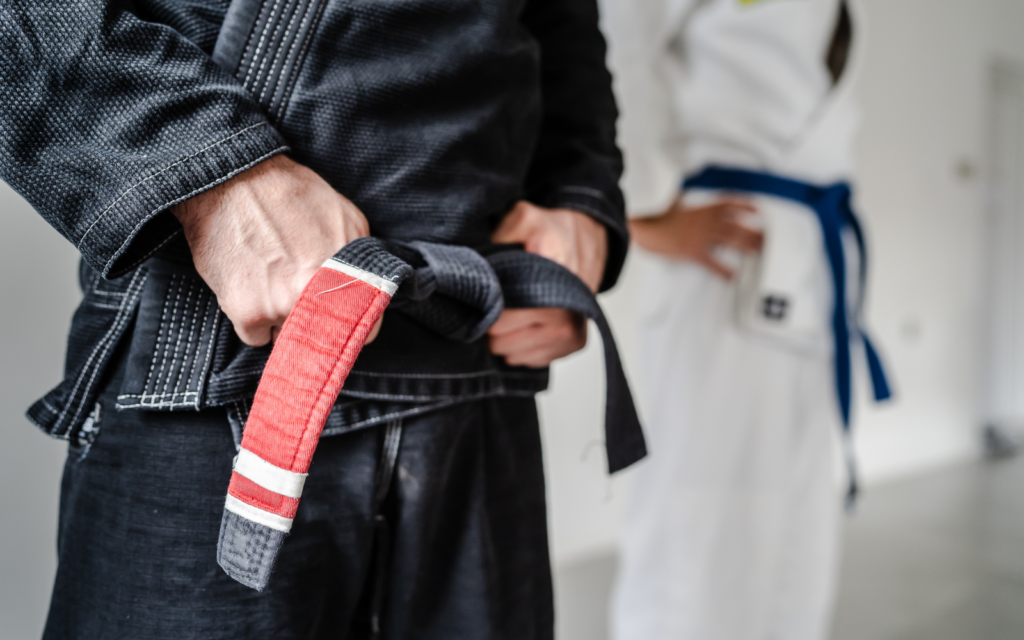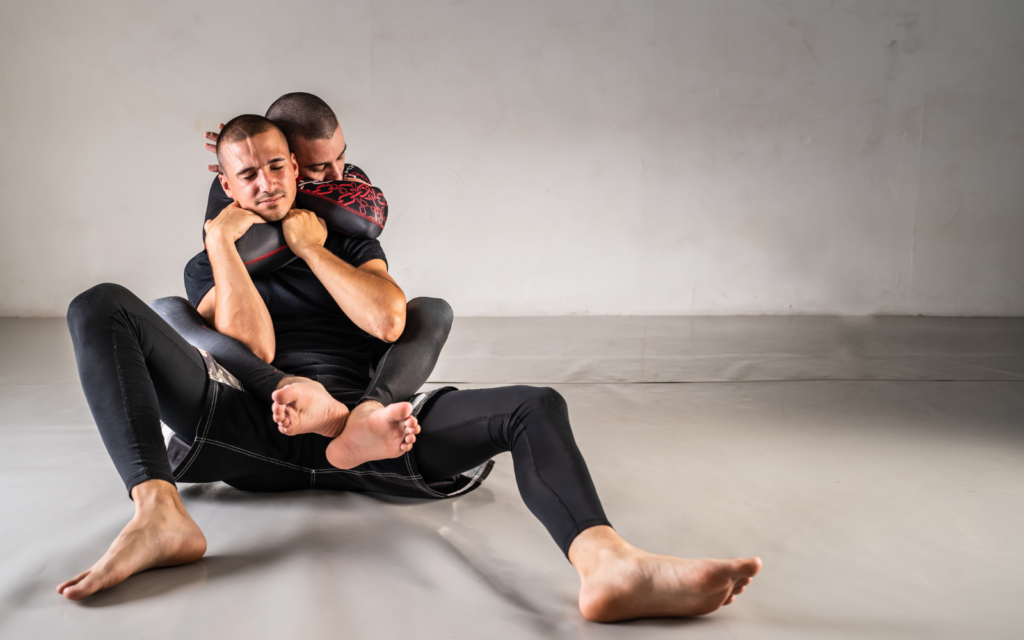Curious to learn how Wrestling vs BJJ (Brazilian Jiu-Jitsu) stack up?
We’ve got you covered below as we’ll share a crash course on the differences and similarities and their history, rules, training, and effectiveness in self-defense situations.
After all, whether you are a fan of one sport or both, understanding the strengths and weaknesses of each can enhance your appreciation and knowledge of the grappling arts and may even help you make better decisions!
Key Differences of Wrestling vs BJJ
Here are some important differences between wrestling and Brazilian Jiu Jitsu (BJJ), which we will then dive deeper into later in the article!
- Wrestling has ancient roots, while BJJ is a modern martial art with origins in Brazil.
- Wrestling focuses on pinning, while BJJ aims for submissions.
- Wrestling places an emphasis on takedowns and throws, while BJJ focuses on ground fighting and submissions.
- Wrestling awards points for takedowns, reversals, and near falls, while BJJ awards points for superior position, sweeps, and submissions.
- Wrestling has more restrictions on moves, while BJJ allows a wider range of techniques.
- Wrestlers wear singlets, while BJJ practitioners wear gis or no-gi attire.
- Wrestling matches are shorter, while BJJ matches can be longer.
- Wrestling prioritizes physical conditioning, while BJJ focuses on technique and adaptability.
Similarities Between Wrestling and BJJ
But there are also some significant similarities between wrestling and BJJ:
- Both wrestling and BJJ are grappling sports that involve close physical contact and control of an opponent (making them both perfect for training with a grappling dummy).
- Both disciplines typically begin in a standing position and rely on takedowns to bring opponents to the ground and establish control.
- Wrestling and BJJ emphasize maintaining control over an opponent on the ground and improving position.
- Practitioners of both sports develop strength, endurance, flexibility, and agility through rigorous training.
- Both disciplines require strategic thinking, adaptability, and problem-solving skills during competitions.
- Wrestling and BJJ also promote values such as respect for opponents, coaches, referees, and good sportsmanship.
- Both sports have local, regional, national, and international competitions that allow athletes to test their skills and progress through the ranks.
- Many athletes find that training in both wrestling and BJJ can complement and enhance their abilities in each discipline.
History
Wrestling is one of the oldest sports known to man, dating back to ancient times with cave drawing and popular in various civilizations, including the Greeks, Romans, and Egyptians.
Each of these cultures developed their unique styles of wrestling, with the most well-known being the Greek Olympic sport of Pankration.

But of course, as one of the oldest forms of combat, wrestling has evolved, incorporating different techniques and styles as it spread across the globe such as Sambo in Russia.
In contrast, Brazilian Jiu-Jitsu (BJJ) is a relatively modern martial art that emerged in the early 20th century. Its inception is closely linked to the Gracie family, who played a pivotal role in its development and popularization. BJJ is heavily influenced by Japanese Judo and Japanese Jiu Jitsu, emphasizing ground fighting and submissions.
Mitsuyo Maeda, a Judo expert, arrived in Brazil in 1914 and began teaching the art to Carlos Gracie, who then passed it on to his brothers. And over the years, the Gracie family refined and adapted the techniques to help smaller people defend against larger opponents, and create the distinct art of BJJ that we know today.
While wrestling boasts a rich and extensive history in Western civilization, BJJ’s recent development has seen it experience rapid growth and global recognition. Both sports have made significant contributions to the martial arts world. And their practitioners continue to dominate mixed martial arts competitions, with several champions in UFC coming from wrestling or BJJ backgrounds.
Rules & Goals
Wrestling is governed by a ruleset focused on takedowns, control, and pinning opponents.
Competitors aim to gain points in a wrestling match by executing takedowns, reversals, escapes, and near falls. The ultimate goal is to pin an opponent’s shoulders to the mat, resulting in an instant victory.
However, certain moves, such as chokes, joint locks, and strikes, are prohibited in wrestling.
But as mentioned, the sport has evolved into various styles, including Greco-Roman wrestling (the style used in the Olympics), freestyle wrestling (originating from Iran and also used in Olympic matches), catch wrestling, and folkstyle (the style used in collegiate wrestling), each with specific rules and restrictions.
On the flip side, Brazilian Jiu-Jitsu (BJJ) is centered around ground fighting, with the primary objective of submitting opponents through joint locks and chokes.
BJJ rules permit a wide range of techniques, including some that are illegal in wrestling, such as leg locks and certain types of guard positions.
Points are awarded for achieving and maintaining dominant positions, executing sweeps and takedowns, and attempting submissions. And matches can be won by accumulating more points than an opponent, achieving a submission, or, in some cases, by referee decision.
But despite their differences, both wrestling and BJJ share a common goal: to reach dominant positions over an opponent through physical control and skillful technique.
Techniques
The techniques to accomplish these goals obviously differ across sports.
For instance, wrestling techniques largely require explosive power, speed, and athleticism, and wrestlers must be skilled in maintaining their balance and leverage to execute them successfully. Some of the most common wrestling techniques include:
- Single leg takedown: The wrestler shoots in on one leg of their opponent and lifts it to off-balance their opponent and bring them to the ground.
- Double leg takedown: Similar to the single leg takedown, but the wrestler shoots in on both legs of their opponent, driving them to the ground.
- High crotch: A takedown where the wrestler reaches under their opponent’s arm and grabs their leg, lifting it up and driving them to the ground.
On the other hand, BJJ practitioners rely more on leverage, technique, and timing over brute strength, emphasizing submissions, sweeps, and guard work.
The ground fighting techniques of BJJ require practitioners to be proficient in controlling and manipulating their opponent’s body while maintaining their balance and positioning.
This often involves using guard positions, such as closed or open guards, and submissions, such as armlocks and triangle chokes. BJJ also includes positional control techniques like mount, side control, and back control, which aim to establish dominant positions and set up submissions (and if you’re interested, be sure to learn all about basic BJJ moves here).
But like with the rules and goals, there is some overlap in their techniques.
Wrestlers may employ ground control techniques like pins and cradles to control their opponents on the mat. And BJJ practitioners may use takedowns to bring opponents to the ground and set up their ground game.
Uniform
In wrestling, competitors wear a one-piece tight-fitting garment called a singlet designed to minimize opponents’ ability to grab onto clothing. The singlet is typically made of stretchy material covering the torso down to the thighs but leaving the rest free (learn more about the singlet and what wrestlers wear under their singlets here).
Amateur wrestlers also wear wrestling shoes, which provide additional grip on the mat and support for the ankle.
In contrast, BJJ practitioners may wear a gi, a traditional martial arts uniform consisting of a jacket, pants, and a belt.
The gi is usually made of heavy cotton material, designed to withstand the rigors of ground fighting and grappling.
The jacket features a thick collar that can be used for chokes and other submission techniques. The pants are typically loose-fitting and reinforced at the knees to withstand the wear and tear of training and competition.
It’s what Royce Gracie wore when he won UFC 1, 2, and 4.
But modern BJJ practitioners typically train and compete in no-gi attire, consisting of a rash guard and grappling shorts.
Like the singlet, this is designed to provide freedom of movement while minimizing the ability of opponents to grab onto clothing. No-gi attire is also typically made of stretchy and breathable material for maximum comfort.
Ranking System
Wrestling and Brazilian Jiu-Jitsu (BJJ) have different ranking systems that reflect the progression of an athlete’s skills and experience.
There is no formal ranking system in wrestling, and athletes are often grouped by age, weight class (unlike BJJ weight classes), and skill level in competitions. However, wrestlers may earn awards such as medals, trophies, or championships for their achievements in competition.
In contrast, the BJJ belt system denotes a practitioner’s level of expertise and experience. The system starts with a white belt and progresses through blue, purple, brown, and black belts. BJJ practitioners must earn stripes on their belts to signify their progress toward the next rank, and the time it takes to progress from one belt to the next can vary widely, with the highest-ranking belts often taking several years to achieve.

The BJJ ranking system emphasizes the importance of dedication, hard work, and consistent practice in developing technical skills and proficiency.
And the progression through the ranks is not only a measure of an athlete’s technical ability but also a reflection of their personal growth and commitment to the sport.
Training Regimine
Because of their different techniques in reaching a shared goal to dominate opponents, their training is quite different.
Wrestling training is often considered one of the most difficult and strenuous things a person can do.
That’s because it requires developing explosive power, strength, and agility through drills, conditioning, and technique work.
Wrestlers will often spend time drilling takedowns and throws, working on maintaining balance and control on the mat and practicing specific wrestling techniques such as the cradle or half-nelson.
On the other hand, since BJJ relies more on technique and strategy, practitioners aim to perfect their ground fighting and submission skills through extensive drilling of techniques, working on positional control, and practicing live rolling sessions against opponents to develop timing and adaptability.
BJJ training also incorporates sparring, where practitioners simulate competition scenarios to refine their skills and improve their overall fitness and conditioning.

In short, wrestling training is often geared toward developing explosive power and strength, while BJJ training emphasizes technique, strategy, and adaptability.
What is Submission Wrestling?
Submission wrestling is a hybrid grappling sport that combines techniques from Brazilian Jiu-Jitsu (BJJ), amateur wrestling, and other grappling disciplines. The primary objective of submission wrestling is to force an opponent to submit through joint locks or chokes, similar to BJJ.
Submission wrestling also allows a wider range of techniques than amateur wrestling, including leg locks and certain types of takedowns and throws that may be illegal in wrestling.
Wrestling vs BJJ: What is Better For Self Defense in a Street Fight?
When it comes to self-defense in a street fight, both wrestling and Brazilian Jiu-Jitsu (BJJ) can be effective, but each has its pros and cons in a real life situation.
Wrestling can be helpful in a situation where an attacker is attempting to take you down or lift you off the ground. That’s because wrestling teaches takedown defense and techniques for maintaining balance and leverage.
But if you did get taken down, then BJJ ground fighting would come in handy thanks to its control and submission techniques that can be used to neutralize an attacker and prevent further harm.
However, it’s important to remember that there are no rules or referees in a street fight, and attackers may use weapons or have accomplices. And both sports focus on one-on-one fighting, while real-world self-defense situations often involve multiple attackers or unexpected variables.
Of course, the best approach to self-defense is to develop a well-rounded set of skills that includes striking, such as Muay Thai for self defense, situational awareness, and conflict resolution.
While wrestling and BJJ can be valuable components of a self-defense strategy, they are not a complete solution. And as always, it’s usually better to avoid a physical altercation altogether and run ;).
Wrestling vs BJJ Summed Up
To sum it all up, wrestling and Brazilian Jiu-Jitsu (BJJ) are two grappling sports that offer unique styles and techniques for athletes and enthusiasts alike.
Wrestling emphasizes takedowns, control, and pinning, while BJJ focuses on ground fighting, submissions, and positional control.
And despite their differences, both sports require cardio and general physical fitness, skill, and strategy.
So, hope you’ve found this comparison breakdown helpful!
